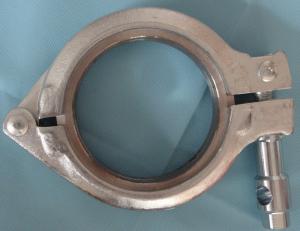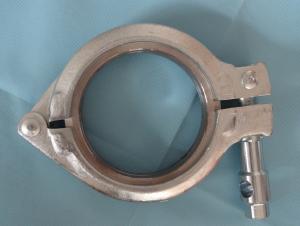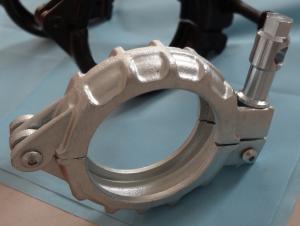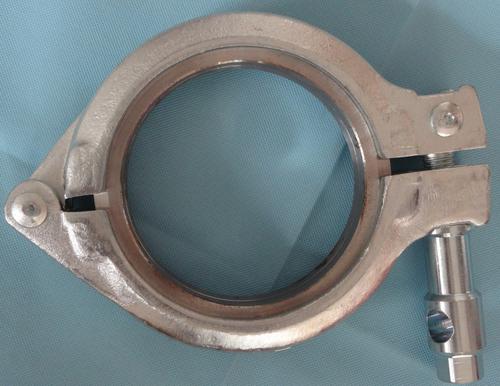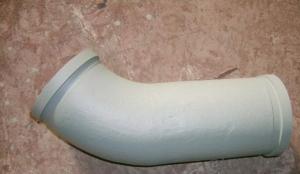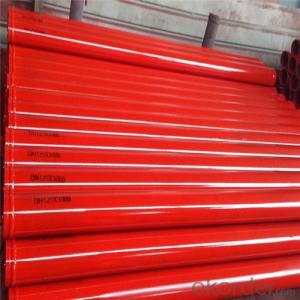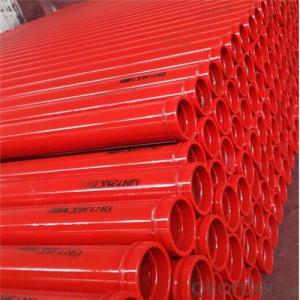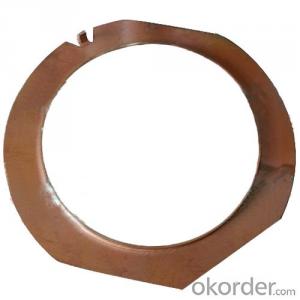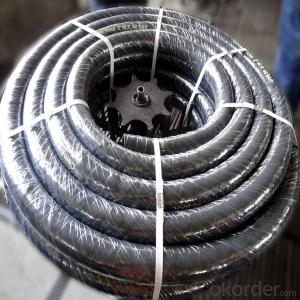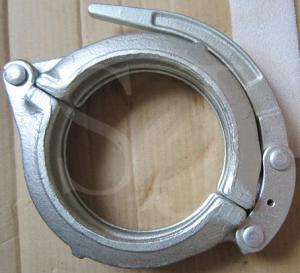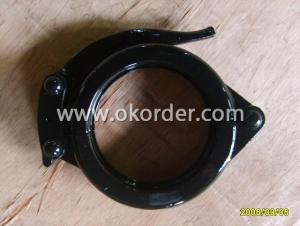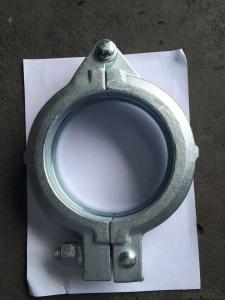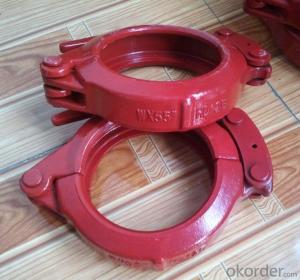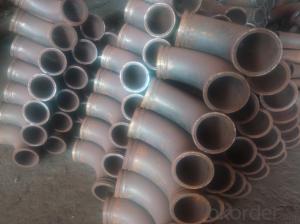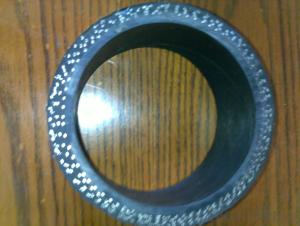Long Bolt Coupling DN125 with High Quality
- Loading Port:
- Tianjin
- Payment Terms:
- TT or LC
- Min Order Qty:
- 5 pc
- Supply Capability:
- 5000 pc/month
OKorder Service Pledge
OKorder Financial Service
You Might Also Like
Product Description:
Name:Long Bolt Coupling DN125 with High Quality
Type: Snap coupling, Bolt coupling, Wedge Coupling, adjustable or mounting type
Dimensions: DN125, 5"
Process: Casting or Forging.
Surface treatment: Painted or Galvanized.
Notes: total series of concrete pump clamp for different brand concrete pump(PUTZMEISTER, SCHWING, CIFA, SANY, ZOOMLION, IHI, KYOKUTO Etc) available from us, such as Snap coupling, Bolt coupling, Wedge Coupling, adjustable or mounting type .
Scope of Application of the Equipment
Long Bolt Coupling DN125 with High Quality widely used on concrete pump truck, concrete placing boom, trailer concrete pump etc, for concrete delivery pipe connection.
Our Long Bolt Coupling DN125 with High Quality have been successfully exported to many countries from 1998, Our main markets as below: Middle East, Southeast Asia, America, Brazil, Italy, Russia, South Africa etc
Aiming at the largest concrete pump parts manufacturer, and reliable, professional supplier in China, we can supply concrete pump elbows, delivery pipes, casting or forging couplings, end rubber hoses, rubber pistons, tungsten wear plates, delivery cylinders, and other hydraulic parts, one stop service for your concrete pump parts and accessory business.
Product Advantages:
Long Bolt Coupling DN125 with High Quality are durable, strong, and resists corrosion.
Main Product Features:
· Premium quality
· Prompt delivery & seaworthy packing (10-20 days after receiving deposit)
Reliable performance
Easy and smooth operation
High safety.
· Professional Service
· Competitive pricing
Product Specifications:
Every 300pcs put in one seaworthy wooden box, and 20 boxes in one 20feet container.
FAQ:
Q1: Why buy Materials & Equipment from us?
A1: All products are through its ISO certifications, adhere to the highest standards and a commitment to supply chain safety and customer satisfaction.
Q2: How do we guarantee the quality of our products?
A2: We have established an advanced quality management system which conducts strict quality tests at every step, from raw materials to the final product. At the same time, we provide extensive follow-up service assurances as required.
Q3: How soon can we receive the product after purchase?
A3: Within three days of placing an order, we will begin production. The specific shipping date is dependent upon international and government factors, but is typically 10 to 30 workdays.
Q4: If we can produce some Long Bolt Coupling DN125 with High Quality according to customers request?
A4: Yes, we can produce Long Bolt Coupling DN125 with High Quality according to the difference country situations and different concrete pump to make it suitable to the market and customers. We have very professional technical team to make the design.
Q5: How to make a quick resolution for after service?
A5:We have overseas branches all-around of world, IF needed, the seller shall dispatch 2 engineers to the buyer's site for supervision of training. The buyer shall make available of necessary facilities &skilled personnel at site for training.
Images:
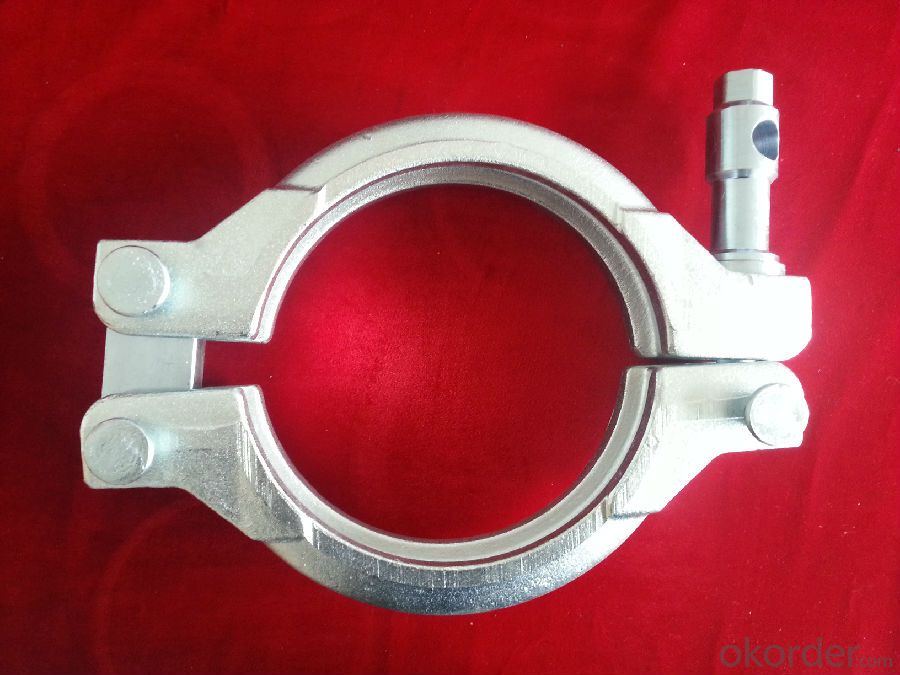
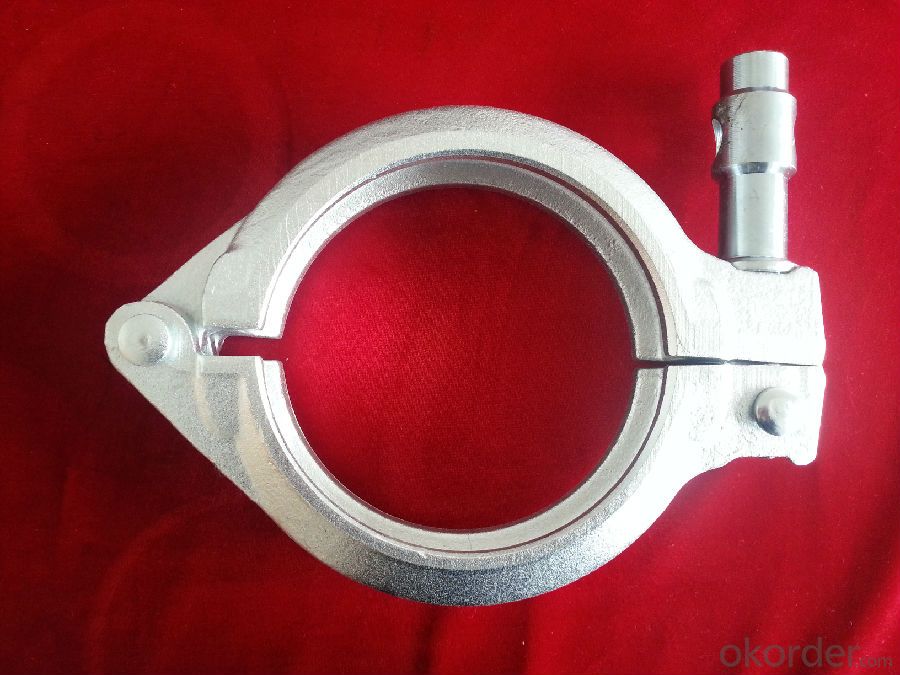
- Q: Can concrete pump spare parts be inspected or certified by third-party organizations?
- Concrete pump spare parts have the potential to undergo inspection and certification from third-party organizations. These organizations are usually independent and possess the necessary knowledge and resources to assess the quality, performance, and safety of these spare parts. They adhere to industry-specific standards and guidelines while conducting inspections, tests, and audits to ascertain whether the spare parts meet the required criteria. The certification provided by these third-party organizations serves as a guarantee to customers that the spare parts have been evaluated and found to be in line with the relevant standards. This helps to foster trust and confidence in the products, ensuring their reliability and suitability for concrete pump usage.
- Q: Can concrete pump spare parts be coated with UV-resistant coatings for outdoor applications?
- Concrete pump spare parts can benefit from the application of UV-resistant coatings to protect them from the damaging effects of UV radiation. These coatings are specially designed to prevent fading, cracking, and deterioration over time. By coating the spare parts, they are shielded from prolonged exposure to sunlight and other environmental factors, thus extending their lifespan and ensuring optimal performance outdoors. Furthermore, these coatings offer additional protection against weathering, including moisture, temperature fluctuations, and chemical exposure. As a result, it is highly recommended to coat concrete pump spare parts with UV-resistant coatings in order to enhance their durability and maintain their functionality when used outside.
- Q: How does a hopper agitator motor ensure consistent concrete mixing?
- A hopper agitator motor ensures consistent concrete mixing by providing the necessary agitation and movement within the hopper. The motor is designed to rotate and move the agitator blades, which helps in effectively mixing the concrete ingredients. The primary function of the hopper agitator motor is to prevent the concrete from settling or segregating during the mixing process. As the motor rotates, it creates a swirling motion inside the hopper, ensuring that all the ingredients are evenly distributed and thoroughly mixed. This prevents any clumps or inconsistencies in the final concrete mixture. Additionally, the motor also helps in breaking up any lumps or clusters that may have formed within the hopper. This action further enhances the uniformity of the mixture and ensures that all the components, such as cement, aggregates, water, and additives, are properly blended together. Furthermore, the continuous movement of the agitator blades also helps in maintaining the desired consistency and homogeneity of the concrete mix. It prevents the heavier particles from settling at the bottom of the hopper, ensuring that the mixture remains consistent throughout the entire mixing process. Overall, the hopper agitator motor plays a crucial role in ensuring consistent concrete mixing by providing the necessary agitation, preventing segregation, breaking up lumps, and maintaining uniformity. Its rotational motion and strategically designed agitator blades help in achieving a well-mixed and homogeneous concrete mixture, which is essential for producing high-quality and durable concrete structures.
- Q: How do I identify the right spare part for my concrete pump model?
- To identify the right spare part for your concrete pump model, you should start by referring to the user manual or documentation provided by the manufacturer. This will usually include a detailed parts list and diagrams specific to your model. If you don't have access to the manual, you can contact the manufacturer or a reputable supplier for assistance. They will require information such as the pump model number, serial number, and specific details about the part you need. It's important to provide as much accurate information as possible to ensure you get the correct spare part for your concrete pump.
- Q: What are the common challenges in sourcing spare parts for stationary concrete pumps?
- The common challenges in sourcing spare parts for stationary concrete pumps include limited availability, long lead times, high costs, and compatibility issues with older models. Additionally, the need for genuine parts from reputable manufacturers is crucial to ensure optimal performance and avoid potential breakdowns or safety risks.
- Q: What do these types of concrete pumps mean?
- HBT represents the ground pump (tow pump). 80 represents the theoretical throughput per hour, and 16 is the maximum outlet pressure of 16 MPa
- Q: How can a faulty electric motor affect the pump's performance?
- The performance of the pump can be significantly affected by a defective electric motor. To begin with, the motor is responsible for supplying the necessary power to operate the pump. If the motor is faulty, it may fail to generate the required amount of power, leading to a decline in the pump's performance and efficiency. This can result in decreased flow rates and lower pressure output, which in turn hampers the pump's functioning. Furthermore, a defective motor can also give rise to problems such as increased energy consumption and overheating. In case the motor is not working properly, it may consume excessive electrical current, resulting in higher energy usage and elevated operational costs. Moreover, an overheating motor can cause damage to the pump and other associated components, thereby further affecting performance and potentially leading to expensive repairs or replacements. Moreover, the reliability and lifespan of the pump can also be compromised by a defective motor. Operating the pump continuously with a faulty motor can subject it to excessive strain, resulting in premature wear and tear, heightened maintenance requirements, and a shorter lifespan. Consequently, frequent breakdowns, downtime, and a decline in overall productivity may occur. In conclusion, a defective electric motor can have various adverse effects on the pump's performance, including reduced flow rates, diminished pressure output, increased energy consumption, overheating, and decreased reliability. Therefore, it is crucial to regularly inspect and maintain motors to ensure their optimal functioning and prevent any detrimental impact on the pump's performance.
- Q: How do concrete pump spare parts contribute to the overall performance of the pump?
- Enhancing the overall performance of the pump, concrete pump spare parts play a crucial role. These spare parts are specifically designed to endure the harsh and demanding conditions of pumping concrete, guaranteeing the efficiency and longevity of the pump. An important factor in the pump's overall performance is the ability of concrete pump spare parts to enhance pumping capacity and efficiency. These spare parts, including pump cylinders, pistons, and valves, are designed to ensure a consistent and smooth flow of concrete without any interruptions. By maintaining a steady flow, these spare parts maximize the pump's capacity, enabling it to handle larger volumes of concrete in less time. Furthermore, concrete pump spare parts contribute to the pump's performance by improving its durability and reliability. These spare parts are made from high-quality materials like hardened steel and wear-resistant alloys, specifically chosen to withstand the abrasive nature of concrete. This ensures that the pump can operate continuously without experiencing premature wear or failure. Concrete pump spare parts also ensure the safety of the pump operators and the environment. For instance, wear plates and cutting rings prevent concrete leakage, reducing the risk of accidents and environmental contamination. Similarly, seals and gaskets provide a secure and tight connection between different components, preventing leaks or malfunctions. Moreover, concrete pump spare parts reduce downtime and maintenance costs. As these spare parts undergo wear and tear during operation, they are designed to be easily replaceable. This allows for quick and efficient repair or replacement of damaged parts, minimizing the pump's downtime. Additionally, using genuine and high-quality spare parts reduces the need for frequent repairs and maintenance, resulting in lower overall maintenance costs. In conclusion, concrete pump spare parts are vital components that significantly contribute to the pump's overall performance. They enhance its pumping capacity, durability, and reliability, ensuring a smooth and efficient operation. Furthermore, these spare parts promote safety, reduce downtime, and minimize maintenance costs, making them indispensable for the optimal performance of concrete pumps.
- Q: How can one source reliable suppliers for concrete pump spare parts?
- To find reliable suppliers for concrete pump spare parts, several steps can be taken. Firstly, conducting comprehensive research on potential suppliers is crucial. This involves searching online directories, industry forums, and construction equipment and spare parts marketplaces. Valuable insights into the reliability and quality of the suppliers can be gained by reading customer reviews and ratings. Secondly, seeking advice and recommendations from experienced industry professionals and experts in the concrete pump industry is advisable. They can provide references for reliable suppliers they have previously worked with. Attending trade shows and exhibitions related to the construction industry is also a beneficial way to connect with suppliers and evaluate their product offerings in person. This allows for direct communication and the opportunity to assess the reliability and quality of their spare parts. Additionally, requesting samples or product catalogs from potential suppliers is essential to ensure that the spare parts meet the required specifications and quality standards. This helps in assessing the reliability of the suppliers and the compatibility of their products with the concrete pump. Furthermore, conducting background checks on the suppliers is crucial. Verifying their credentials, certifications, and licenses provides assurance of their reliability and professionalism. Inquiring about their manufacturing processes and quality control measures is also beneficial to ensure the consistency and durability of the spare parts. Lastly, comparing prices, warranties, and after-sales services offered by different suppliers aids in making an informed decision. Striking a balance between cost and reliability is important to establish a long-term and fruitful partnership. By following these steps and thoroughly evaluating and researching potential suppliers, reliable suppliers for concrete pump spare parts can be sourced. This ensures the smooth operation and maintenance of equipment.
- Q: Can I reuse old concrete pump spare parts?
- Reusing old concrete pump spare parts is a possibility, depending on their condition. In the event that the spare parts are in good working order and successfully pass the required inspections, they can be reused to cut costs and minimize waste. Nevertheless, it is crucial to verify that the recycled spare parts are suitable for the specific model and type of concrete pump in use. Seeking advice from a professional or the manufacturer is advised in order to ascertain the safety of reusing the old spare parts.
Send your message to us
Long Bolt Coupling DN125 with High Quality
- Loading Port:
- Tianjin
- Payment Terms:
- TT or LC
- Min Order Qty:
- 5 pc
- Supply Capability:
- 5000 pc/month
OKorder Service Pledge
OKorder Financial Service
Similar products
Hot products
Hot Searches
Related keywords
